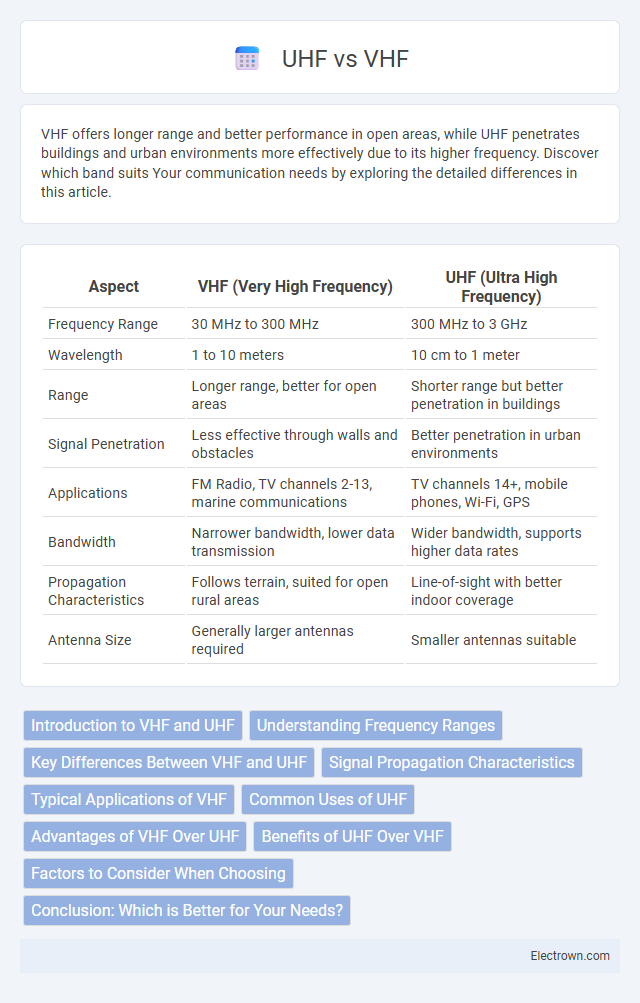VHF offers longer range and better performance in open areas, while UHF penetrates buildings and urban environments more effectively due to its higher frequency. Discover which band suits Your communication needs by exploring the detailed differences in this article.
Table of Comparison
| Aspect | VHF (Very High Frequency) | UHF (Ultra High Frequency) |
|---|---|---|
| Frequency Range | 30 MHz to 300 MHz | 300 MHz to 3 GHz |
| Wavelength | 1 to 10 meters | 10 cm to 1 meter |
| Range | Longer range, better for open areas | Shorter range but better penetration in buildings |
| Signal Penetration | Less effective through walls and obstacles | Better penetration in urban environments |
| Applications | FM Radio, TV channels 2-13, marine communications | TV channels 14+, mobile phones, Wi-Fi, GPS |
| Bandwidth | Narrower bandwidth, lower data transmission | Wider bandwidth, supports higher data rates |
| Propagation Characteristics | Follows terrain, suited for open rural areas | Line-of-sight with better indoor coverage |
| Antenna Size | Generally larger antennas required | Smaller antennas suitable |
Introduction to VHF and UHF
VHF (Very High Frequency) ranges from 30 MHz to 300 MHz, commonly used for FM radio broadcasting, television signals, and marine communications due to its longer wavelength and better propagation over distances. UHF (Ultra High Frequency) spans 300 MHz to 3 GHz, favored for cellular phones, GPS, Wi-Fi, and digital television because of its shorter wavelength allowing higher bandwidth and better penetration in urban environments. Both VHF and UHF serve distinct roles in wireless communication based on their frequency characteristics and application requirements.
Understanding Frequency Ranges
VHF (Very High Frequency) operates within the 30 MHz to 300 MHz range, offering longer wavelengths that penetrate obstacles and travel greater distances, making it ideal for outdoor communication and radio broadcasting. UHF (Ultra High Frequency) spans from 300 MHz to 3 GHz, featuring shorter wavelengths that provide better signal clarity over shorter distances and improved indoor reception. Understanding these frequency ranges is crucial for selecting the right band for applications such as television broadcasts, walkie-talkies, and wireless devices.
Key Differences Between VHF and UHF
VHF (Very High Frequency) ranges from 30 MHz to 300 MHz, offering longer wavelengths that penetrate structures better and cover greater distances, making it ideal for outdoor broadcasting and marine communications. UHF (Ultra High Frequency) operates between 300 MHz and 3 GHz, providing shorter wavelengths that support higher bandwidth and improved signal quality for urban environments, such as television broadcasting and mobile networks. Key differences lie in signal propagation, with VHF excelling in range and UHF excelling in data capacity and resistance to interference.
Signal Propagation Characteristics
VHF signals operate at lower frequencies, allowing them to travel longer distances and penetrate obstacles like buildings and terrain more effectively than UHF signals. UHF signals, however, offer better performance in urban environments due to their shorter wavelength, which supports higher bandwidth and clearer signals in crowded areas. Understanding these signal propagation characteristics helps you choose the right frequency band based on your communication needs and environment.
Typical Applications of VHF
VHF (Very High Frequency) is commonly used in applications such as FM radio broadcasting, television channels 2 through 13, marine and aircraft communication, and two-way land mobile radios for emergency services. Its longer wavelength allows better signal propagation over longer distances and through obstacles like buildings or hills, making it ideal for outdoor and rural communication. Your choice of VHF is particularly beneficial for reliable communication in environments requiring wide-area coverage and minimal interference.
Common Uses of UHF
UHF frequencies, ranging from 300 MHz to 3 GHz, are commonly used for television broadcasting, mobile phones, GPS, Wi-Fi, and Bluetooth devices due to their ability to penetrate buildings and urban environments effectively. Your wireless communication devices often utilize UHF bands to maintain stable connections in densely populated areas. UHF's shorter wavelengths also make it ideal for two-way radios and public safety communication systems.
Advantages of VHF Over UHF
VHF signals offer superior range and penetration through obstacles, making them ideal for long-distance communication and rural areas. VHF frequencies also experience less signal attenuation in atmospheric conditions compared to UHF, enhancing reliability. Medical and aviation industries frequently prefer VHF bands due to their stable propagation and reduced interference.
Benefits of UHF Over VHF
UHF signals offer better penetration through obstacles such as buildings and dense foliage, providing more reliable communication in urban and indoor environments. Your devices operating on UHF frequencies typically experience less interference from atmospheric noise compared to VHF, resulting in clearer audio quality. UHF frequencies also support higher bandwidths, enabling enhanced data transmission for applications like digital communication and video signals.
Factors to Consider When Choosing
When choosing between VHF and UHF frequencies, consider factors such as range, penetration, and interference. VHF signals typically provide longer range and better performance in open rural areas, while UHF signals excel in penetrating buildings and urban environments. Device compatibility and specific communication needs also play crucial roles in selecting the appropriate frequency band.
Conclusion: Which is Better for Your Needs?
VHF and UHF frequencies each offer unique advantages depending on your communication needs, with VHF providing longer range and better performance in open, outdoor environments while UHF excels in penetrating buildings and urban areas. Your choice should be guided by the typical terrain, required range, and interference levels, where VHF suits rural or maritime settings and UHF is ideal for dense urban or indoor use. Evaluating these factors ensures you select the best frequency band to maximize signal clarity and reliability for your specific applications.
VHF vs UHF Infographic

 electrown.com
electrown.com